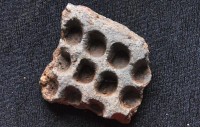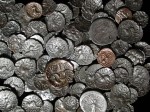 An archaeological survey on the site of future construction in Leicester, central England, has unearthed evidence of an Iron Age mint. More than 20 Iron Age coin molds have been discovered at the Blackfriars site since excavations began in January, so large a number that it strongly suggests the site was a mint used by the local British tribe, the Corieltavi, who had their capital at Leicester.
An archaeological survey on the site of future construction in Leicester, central England, has unearthed evidence of an Iron Age mint. More than 20 Iron Age coin molds have been discovered at the Blackfriars site since excavations began in January, so large a number that it strongly suggests the site was a mint used by the local British tribe, the Corieltavi, who had their capital at Leicester.
 What makes this find particularly exciting is that Leicester is just 15 miles west of Hallaton, the village where a massive treasure including 5,296 British silver and gold coins, 4,835 of them from the Corieltavi tribe, was discovered in 2000. It’s the largest group of Iron Age British coins ever found in Britain. Roman coins and coins from other British tribes were also found at Hallaton, along with a Roman cavalry parade helmet, silver bowls, jewelry, the remains of 400 pigs and several dogs. The site was an open-air shrine in use between 50 B.C. and 60 A.D., with the valuables interred as offerings to the gods.
What makes this find particularly exciting is that Leicester is just 15 miles west of Hallaton, the village where a massive treasure including 5,296 British silver and gold coins, 4,835 of them from the Corieltavi tribe, was discovered in 2000. It’s the largest group of Iron Age British coins ever found in Britain. Roman coins and coins from other British tribes were also found at Hallaton, along with a Roman cavalry parade helmet, silver bowls, jewelry, the remains of 400 pigs and several dogs. The site was an open-air shrine in use between 50 B.C. and 60 A.D., with the valuables interred as offerings to the gods.
 Given that the British coins found at Hallaton make up 10% of the total number of British Iron Age coins ever discovered, it makes sense that there would be a nearby source, like, say, a Corieltavi mint in Leicester. The molds don’t have reverse images to identify the kinds of coins struck. They were dated to the early 1st century A.D. thanks to fragments of high status pottery recovered from the ditch where the first coin mold was found.
Given that the British coins found at Hallaton make up 10% of the total number of British Iron Age coins ever discovered, it makes sense that there would be a nearby source, like, say, a Corieltavi mint in Leicester. The molds don’t have reverse images to identify the kinds of coins struck. They were dated to the early 1st century A.D. thanks to fragments of high status pottery recovered from the ditch where the first coin mold was found.
 The site appears to have been an enclosure in the British Iron Age. There were at least two distinct phases of Iron Age activity, followed by at least three phases of Roman activity. Most of the structural remains come Roman phases of occupation, starting with a residential townhouse. There are foundations and partial walls, no floors, but the remains of mosaic tesserae and painted plaster that indicate the house was highly decorated and therefore expensive. There was also a colonnade, as evidenced by surviving column bases. The walls were thick and supported by buttresses so it must have been a building of considerably size.
The site appears to have been an enclosure in the British Iron Age. There were at least two distinct phases of Iron Age activity, followed by at least three phases of Roman activity. Most of the structural remains come Roman phases of occupation, starting with a residential townhouse. There are foundations and partial walls, no floors, but the remains of mosaic tesserae and painted plaster that indicate the house was highly decorated and therefore expensive. There was also a colonnade, as evidenced by surviving column bases. The walls were thick and supported by buttresses so it must have been a building of considerably size.
Inside the building evidence of burning and of a kiln over multiple floor layers suggest at some point this building was dedicated to industrial use, perhaps the production of roof and floor tiles. Several tiles have been found bearing the adorable signs of why they were discarded.
The team also found a Roman tile in the northern half of the site, with what appear to be dog paw imprints embedded in the ceramic.
Nick said: “When tiles were made in Roman times, they used to get local clay and leave it out in the sun to dry and pets and animals used to escape across them leaving these kinds of imprints – it was quite a common thing to find.
“We’ve also found some floor or roof tiles with sheep or goat prints here as well.”
 Also one with what may be cat prints judging by the size, shape and the absence of visible claws.
Also one with what may be cat prints judging by the size, shape and the absence of visible claws.
Much of the masonry and columns were lost over time, probably repurposed in the Middle Ages for construction of the Blackfriars Priory. There are several instances of medieval construction features cut into the Roman archaeology, plus the remains of medieval pottery and cesspits.
woopee!!!
Ancient coin values must have really dropped with all these hoard finds.
Yes, unfortunately this is true